Breathless is not always an indication of on-coming medical crisis or pathology. Events (including cultural events) can stop us short or knock the wind out of us. And although the experience may be more common at live music events, it happens in galleries and museums, too. But at the close of 2023, the breathlessness we may have experienced intermittently in galleries blurs with a breathlessness we now encounter on an almost daily basis. The dark days of Fall 2023 are giving way to a spectral winter at the start of a political year where it seems as if the entire planet hangs in the balance.
Whether or not we saw this darkness specifically in work exhibited in L.A.’s galleries and museums, there was a great deal that reflected the bleak poetry of a planet and biosphere on the brink of catastrophe; a reflection of the earth’s generosity and a sense of irretrievable loss beneath it; the reflection of humankind confronting one another—alternately frightened, fascinated, and repulsed. In the meantime, L.A.’s galleries continue to burgeon and thrive. Galleries are now as strong as the artists they represent—reflected in the fact that some of the best shows of the year were group shows. The same might be said of its museums—and one show and one museum in particular. Closing out a year of stellar exhibitions, the Hammer Museum’s 2023 Made In L.A. biennial was perhaps its strongest ever. As Ann Philbin prepares to close out her tenure as Director, the L.A. contemporary art community owes her a tremendous debt of gratitude.

Max Hooper Schneider, Falling Angel (2023) Aircraft wreckage, fluorescent light tubes, Tesla coils, vintage neon signs, chains, crushed concrete, mixed media fiberglass pond, microcontroller, 156 x 99 x 162 inches (396.5 x 251.5 x 411.5 cm.). Courtesy François Ghebaly Gallery.
Max Hooper Schneider — Falling Angels
François Ghebaly Gallery
May 6, – June 20, 2023
Here’s a riddle: how many Lucifers does it take to crash a planet? The title carried a whiff of Milton’s Paradise Lost brimstone, and the exhibition’s drama fully measured up to it. The Lucifers crash, proliferate and burrow down into Schneider’s visionary lab and landscapes that many of us who have followed Schneider’s career over the last decade might have seen as nothing less than a promise fulfilled.
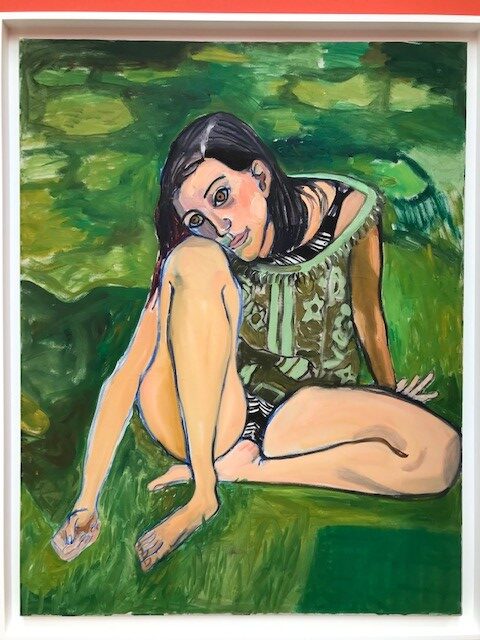
Alice Neel, Nancy Greene, c. 1965; oil on canvas, 47 1/2 x 37 3/8 x 2 inches (120.7 x 94.9 x 5.1 cm.) © Alice Neel, Courtesy BLUM.
“Pictures Girls Make”: Portraitures — curated by Alison M. Gingeras
Blum & Poe (now BLUM)
July 2, – October 21, 2023
A breathtakingly expansive survey of portraiture (from the mid-19th century to the present), Gingeras both recontextualized and redefined its domain in an exhibition that would have felt at home at the Met. “Portraits are pictures people make,” she declares definitively, embracing not simply the flux of personal, sexual, racial, ethnic or cultural identity, but an expanded notion of how this can be represented—entering not merely other worlds, but the shadow selves and lives within those worlds.
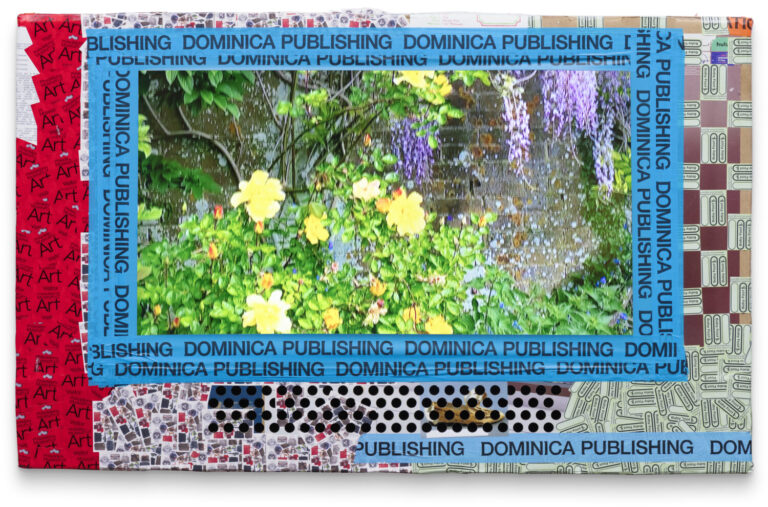
Martine Syms, The Fool, 2021; Laser-cut cardboard, Orafol vinyl with permanent adhesive and tape; digital video, color with sound, 4:11 min; 77.5 x 125.7 x 15.2 cm. © Martine Syms, Courtesy Sprüth Magers.
Martine Syms — Loser Back Home
Sprüth Magers – Los Angeles
June 2, – August 26, 2023
Given the timing, one could almost be excused for thinking Syms planned all along to pull the rug out from beneath what would become the summer’s blockbuster commercial film releases—which coincidentally navigated a similarly fraught domain of self, identity, and something that bore some resemblance to the ‘dysplacement’—the geography of self, its skewed nexus with place, and their continuous decoding, deconstruction, and reconstruction at the heart of her sprawling exhibition. (Or rejection: we might well want to burn it all down). Whether fragile domicile, the skin we inhabit, or merely the point our games come full circle—Syms’ ‘home’ is never less unsettling than the world erupting around it.
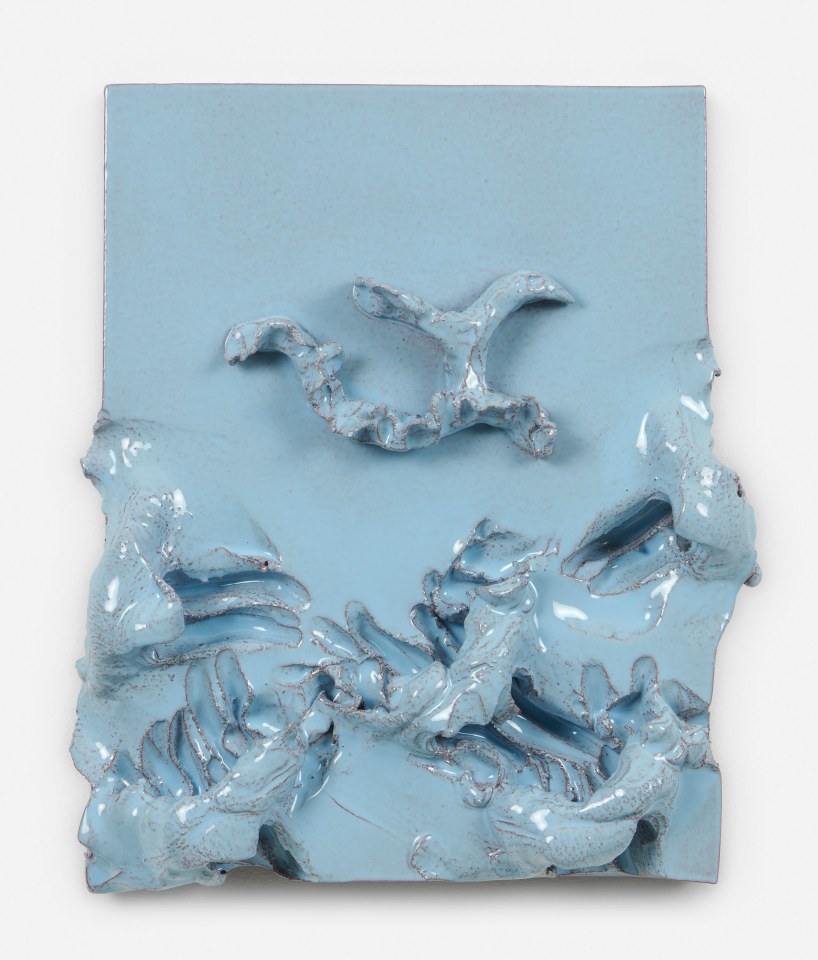
Mai-Thu Perret, She escapes the diamond pitfall and eats up the prickly thorns (2022) glazed ceramic (18 1/2 x 16 x 3 1/4 in. / 47 x 40.6 x 8.3 cm); courtesy David Kordansky Gallery.
Mai-Thu Perret — Mother Sky
David Kordansky Gallery
March 18, – April 22, 2023
Perret has worked in a variety of media over the years, but her affinities for ceramics have come to the fore in recent years, most recently in a residency at the CSULB Center for Contemporary Ceramics, which yielded the expansive circular wall piece at the center of this show—simultaneously a mapping (interior as well as exterior), landscape, and exegetically expressive exorcism. However central to Perret’s ‘sheltering sky’ vision, this title work could not eclipse other works in the show which evinced a similar visionary genius. Words cannot touch it, thought cannot reach it (her haiku-like title for a 2022 work)—yet somehow Perret did just that.
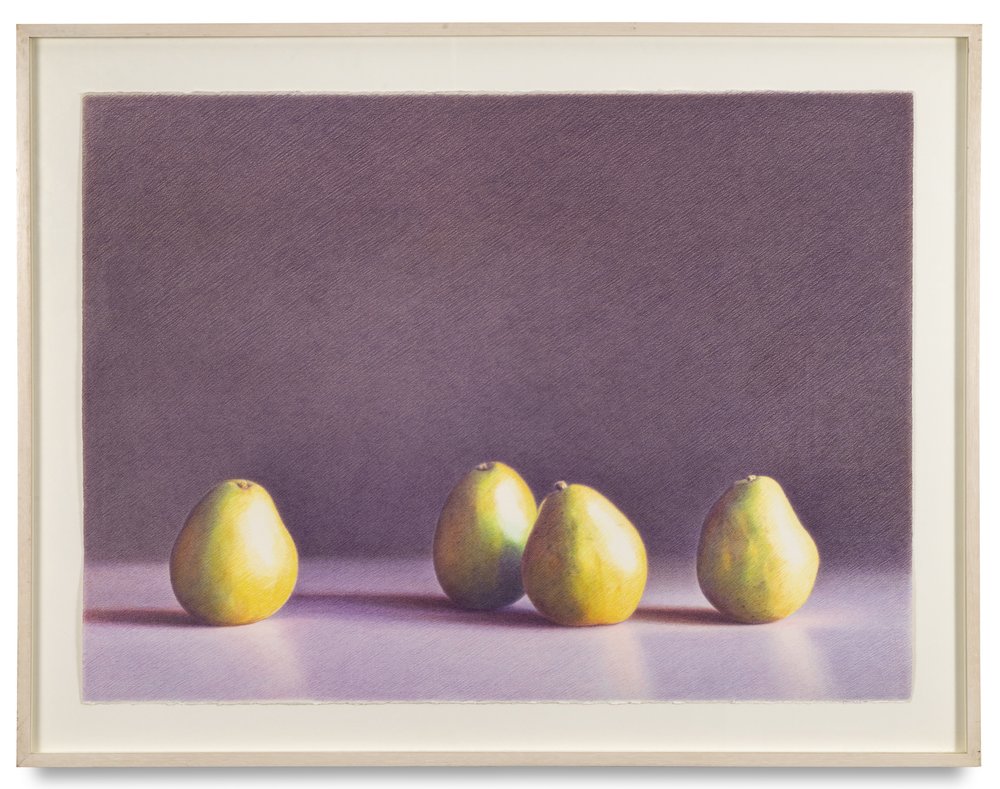
Martha Alf, Four Pears (1989) Verithin colored pencil on paper (22-1/4 x 30 in.) Courtesy Michael Kohn Gallery.
Martha Alf: Opposites and Contradictions
Michael Kohn Gallery
June 24, – August 26, 2023
Alf summarized her approach and intention: “It is about the perfection of the banal and the seriousness of the ridiculous.” This show was that and a whole lot more—really a phenomenology of perception and intention, variously influenced by Minimalism, Pop, and Fluxus, but unique and far more rigorous. She tested spatial and perceptual relationships to their limits and made magic of them. This superbly curated exhibition was nothing less than a poetics of perception.

Installation view, Barbara T. Smith: Proof, ICA-LA” at the Institute of Contemporary Art, Los Angeles.
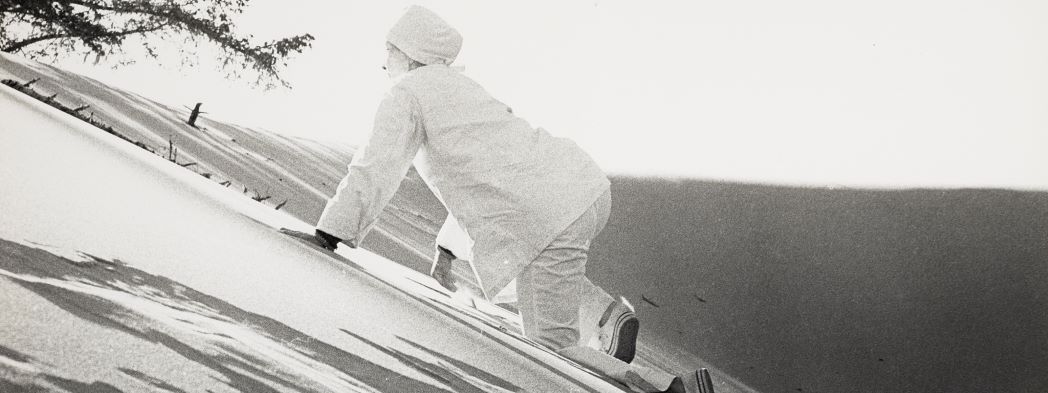
The Way to Be, performed at various locations between San Francisco and Seattle, 1972. “Barbara T. Smith: The Way to Be” at The Getty.
Barbara T. Smith: Proof
Institute of Contemporary Art, Los Angeles
October 7, 2023 – January 14, 2024
Barbara T. Smith: The Way to Be
The Getty [Getty Research Institute]
February 28, – July 16, 2023
The personal is both political and cultural—need proof? Really two shows, taken in conjunction with the Getty Research Institute’s extensive archive of Smith’s documentation, Xerox art and books (or “Coffins”), photographs, objects and memorabilia, Proof, alongside The Way to Be (originally a peripatetic performance repeated in locations between San Francisco and Seattle in 1972 and now the title of her memoir), is effectively a reconstruction of the scaffolding of an artist’s life. Born out of curiosity and inquiry, the feminist second wave, Fluxus, and the frustrations of a one-time suburban homemaker in a broken relationship (a story that could be a template for Six Feet Under’s Ruth Conroy), Barbara T. Smith wrote her second, third, fourth and final acts on her body (almost literally), pioneering performance art, and assembling a body of work to stand alongside a pantheon of her peers.
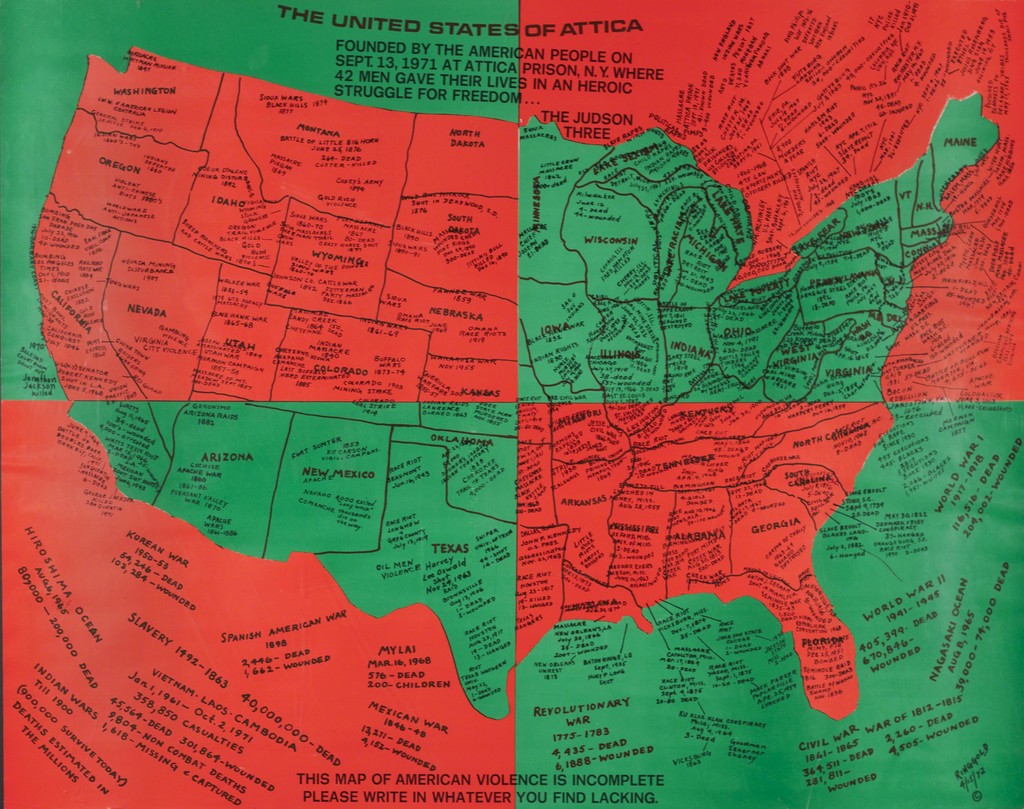
Faith Ringgold, The United States of Attica (1972) offset litho. (21 5/8 × 27 3/8 in. / 55 × 69.6 cm).
Faith Ringgold: A Survey
Jeffrey Deitch – Los Angeles
May 20, – August 19, 2023
Summer isn’t exactly the season it used to be, and aside from being an ‘off-season’ for the commercial art world, our calendars are as likely to be taken up with disaster preparation as vacations. Deitch’s concise but surprisingly comprehensive survey—the first in L.A.—of Faith Ringgold’s ground-breaking work—an authentic protest art at its best and most impactful—was the perfect corrective, distilling the last decades’ human social and political disasters, and simultaneously dissolving distinctions between art and craft into story-telling and perhaps a kind of prayer—anticipating the disasters just around the corner.
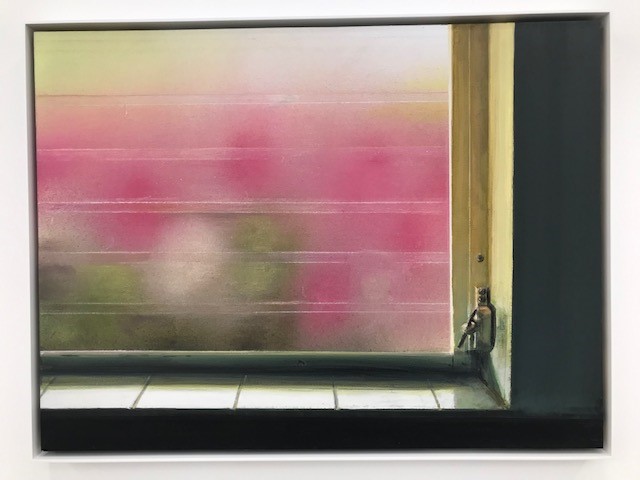
Dike Blair, Untitled, 2020, oil on aluminum (18 x 24 in.; 45.7 x 61.cm.) Courtesy KARMA Los Angeles
Dike Blair
KARMA – Los Angeles
September 16, – November 4, 2023
Dike Blair’s uncannily recomposed photo snapshots rendered in various pigments and supports (in this show, mostly oil on aluminum) remind us of something about the way life actually unfolds, how we remember it, and how we piece it back together. It’s a flash that’s a shadow—or that we might be a little too comfortable relegating to the shadows. It’s about moments and pictures that don’t necessarily tell a story—the interstitial, the in-between, but somehow indelible. This is an art of imagery that doesn’t flinch from banality, yet remains luminous, even incandescent.
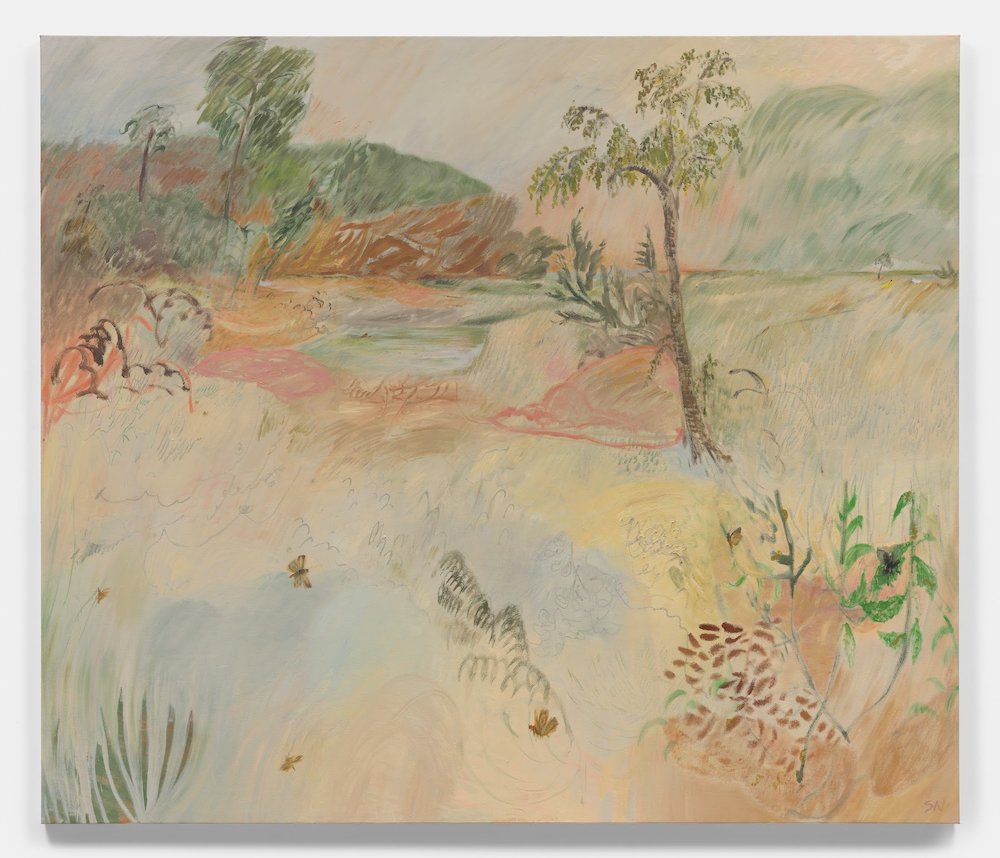
Soumya Netrabile, The Water Hole (2023); oil on canvas (72 x 86 in. / 182.9 x 218.4 cm.) Courtesy Anat Ebgi
Soumya Netrabile: Between past and present / Between appearance and memory
Anat Ebgi – Wilshire Boulevard
September 16, – October 21, 2023
We’re spoiled for great painting in Los Angeles of the 2020s, and for that reason we’re impelled toward making ever more expansive, almost capricious demands on it. But beyond the formal persuasion of the masterpiece that will not be denied is the delight of being taken by surprise—which is what really keeps us coming back. Nor is it necessarily about something entirely new. (The shock of a recovered memory may be sufficient.) Netrabile has her finger precisely on this pulse—recovering a space, a landscape, its features and objects, but reconstructing it without inhibition; retracing steps, but also reinventing her trajectory through it—committing the memory to dream. That approach extended to her palette throughout this show, which recalled Post-Impressionists from Bonnard to early Matisse. Hard to imagine recovering that mythic ‘bonheur de vivre’ anytime soon, but it was alive in this show—and (no doubt) Netrabile’s imagination.

Angeline Rivas, Temporal Narcosis (2023) Acrylic on canvas (36 x 48 in. / 91.44 x 121.92 cm.) Courtesy Chris Sharp Gallery.
Angeline Rivas — MKUltramarine
Chris Sharp Gallery
June 24 – July 29, 2023
The intersection of memory and magic (or at least its invocation) is a complicated, even treacherous domain. I never saw the Joseph Sorrentino film, MK Ultra (2022—although Rivas’s show prompted me to look it up on-line), but I’ve read Philip Agee and listened to a lot of Frank Zappa’s music, which will probably suffice. With airbrush and fluorescent gradients of pinks, blues, greens, and all those colors you thought were liquid sunshine, but were actually just a grease puddle, Rivas channeled the visual dynamic of Kenny Scharf, the spirit of Judy Chicago, a Guimard-nouveau whiplash frenzy and that five-alarm fire where the transcendental gives way to sheer chaos in the most auspicious solo debut of the year.


